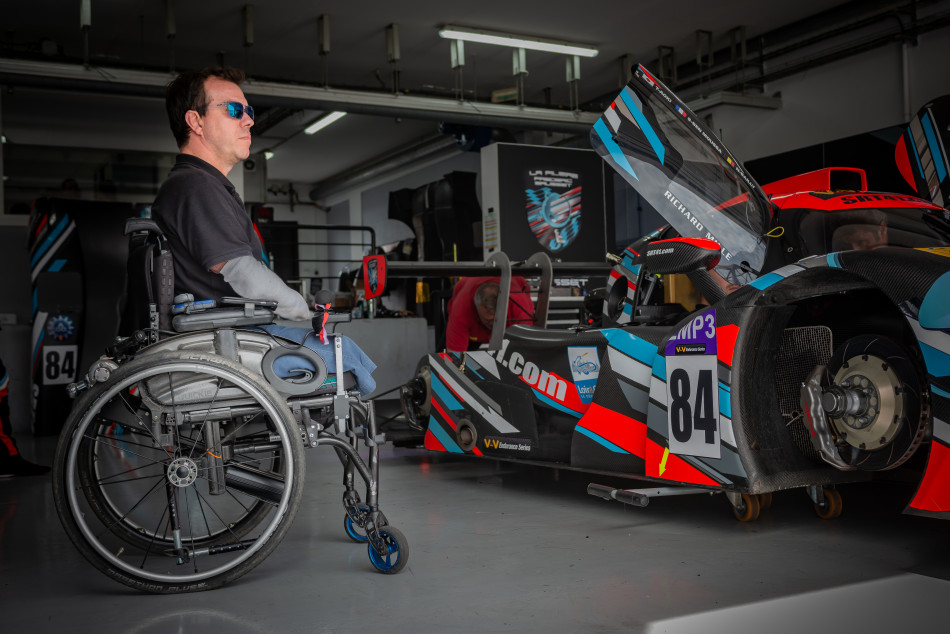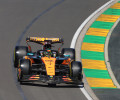SRT41: Mission Le Mans 2020
Two years on from racing in the Le Mans 24 Hours, quadruple amputee Frédéric Sausset is embarking on another incredible motor sport adventure – building a full team of disabled drivers for a season of endurance racing.

Photo by Pascal Aunai
In 2016 Frédéric Sausset stunned the motor racing world by overcoming serious disability as a quadruple amputee to take part in and finish the sport’s most famous endurance race – the Le Mans 24 Hours.
In a tale of remarkable ambition, fortitude and determination, Sausset recovered from a 2012 infection that required his legs to be amputated above the knee and his arms removed at the forearm, and set himself the goal of racing at Le Mans. Four years later, having reinvented the technology and equipment needed to drive a racing car, Sausset steered his specially-adapted Morgan LMP2 prototype across the line and into the history books. It was, however, just the start of the story.
In the week preceding the event, in which he participated as the ‘Garage 56’ entry for innovative technologies and projects, Sausset announced that following the race – with the support of the FIA and Le Mans organiser the Automobile Club de l’Ouest (ACO) – he would endeavour to establish a sports car team for disabled drivers.
In the wake of his ground-breaking achievement at Le Mans, Sausset’s plans seemed to take a back seat as he became a household name in his region – his biography was written and published by French journalist Stefan Lhermitte – and returned to the clothing business he has run with wife Frédérique for the past 26 years. Behind the scenes, however, Sausset was hard at work developing the next chapter of his remarkable tale.
Team building
Via an initiative entitled ‘Un Volant Pour Tous’ (A Wheel for All) the entrepreneur recruited three other disabled drivers to race for his new team – former Japanese MotoGP and Superbike rider Takuma Aoki, Belgian motocross expert Nigel Bailly – both of whom are paraplegic as a result of riding accidents – and Snoussi Ben Moussa, a professional driving instructor for the past 10 years, despite the loss of a hand.
“Our selection was based on human qualities as much as professionalism and driving competence,” says Sausset. “By word of mouth, 38 drivers applied, then 12 came to test at Le Mans on the Bugatti circuit in October 2017.
“They drove my customised Audi R8, with Christophe Tinseau as an instructor in the right-hand seat. And then there were six left to test the Ligier prototype in the afternoon. And then there were three... We need this to be a family,” Sausset insists.
The team made its track debut at the Circuit Paul Ricard in May using a Ligier JSP3 LMP3 car and finishing in 23rd place. A much improved outing at the Dijon-Prenois track in July resulted in a P17 placing.
“The race in Dijon was good – we were only three seconds away from Mathias Beche on a lap, who is a reference in WEC, so this is very positive. The team is getting together slowly, although the change of drivers takes up a lot of time. We are improving technically, physically – for the drivers as well as the mechanics,” says Sausset, adding that he intends to work on the change of driver with motor sport authorities, as it directly impacts on the results of his team.
“This is our major problem because we cannot do it as fast as other drivers,” he says. “We are discussing this aspect with VdeV promoters, the FIA and the French Federation (FFSA). It would be good to have a sort of a Balance of Performance (BoP) to compensate for this situation, because we have a major handicap in that regard.
“We don’t want to have specific disabled series, we want to participate in normal series. This is very important for Gérard Saillant, the president of the FIA Medical Commission,” Sausset stresses.
And he wants his team “to be staying for long, with disabled drivers of a high level [competing] on a regular basis, in various series, not only in endurance racing.”
Despite the difficulties, the steady improvements have continued and last month, at the Circuito de Navarra in Spain, at the end of a six-hour race, the team of rookies claimed P13.
Two rounds of the VdeV remain – the Four Hours of Le Mans in October and the Six Hours of Estoril in November. Beyond this year’s series the chief goal is Le Mans 2020. The ACO president, Pierre Fillon, has already validated an entry for La Filière Sausset, with the team boss set to return to Garage 56.
“We are preparing for 2019, discussing things with Gérard Neveu [the head of WEC], who is supporting this project, to push for a French academy for high-level disabled drivers,” says Sausset. “We have a lot of significant media attention, but not enough, I believe, with regards to the level of performance of our three drivers. [The sport] remains complicated in terms of sponsorship – even for the big teams – but I believe we bring something completely different, a different set of social and societal values, a different perspective.”
So what about the European Le Mans Series (ELMS) in 2019 as a stepping stone to Le Mans the following year? “Next year would be a problem in terms of budget, so we prefer to postpone ELMS to 2020, before Le Mans, in case we race in GTE at the 24 Hours,” explains Sausset. “At one point the Michelin Le Mans Cup appeared to be an option, but two hours with three drivers is not long enough for us. We are still looking for funding, and it’s not easy.”
You cannot stop a man from dreaming and Sausset’s restless mind is also looking at targets beyond his endurance team, including testing a Formula E single-seater. “I want to discuss this with [FIA president] Jean Todt as soon as possible. It could be easier, because of the technology on hand, for disabled drivers. In Formula E, you only have to accelerate and brake. The software for our LMP2 car at Le Mans worked well and I am sure it can be adapted to other racing cars, along with the new Le Mans project.
“I would like to progress on the Formula E testing project. We also need to convince potential partners that we need extra funding, and that an investment in La Filière is a sensible decision,” the boss adds. His 2016 Morgan
LMP2 prototype is now at Le Mans’ ‘Museum of the 24 Hours’.
The credibility is there, Sausset believes. “We have a Belgian guy, a Japanese guy, Takuma [Aoki] did MotoGP so he has a big impact in Japan. We’re even considering organising a demonstration in North America and another one in Asia, then one in Japan for the Olympic Games in Tokyo in 2020. We need extra budgets in addition to the budget of La Filière.”
The next selection process for the team will start in 2020, for a new three-year cycle. Gentlemen, start your engines...
Racing for all
At the end of last year the FIA established a new Disability and Accessibility Commission. Its president, Nathalie McGloin, explains what the group has set out to achieve.
What is the remit of the FIA’s Disability and Accessibility Commission?
“The remit is simple: to make motor sport the most inclusive sport in the world without compromising safety. It is my personal mission to show the world that this sport is for everyone.”
The commission was established at the end of 2017. What are the initial goals?
“The main pillars this year are to create a Global Disabled Licencing Process, work on the Back To Racing programme for existing drivers who have suffered life-changing injuries and wish to continue in motor sport, and to work on a strategy for guidance on approved adaptations for competition vehicles.”
Is there more to be done away from the cockpit as well, in terms of how accessible motor sport is for everybody attending or working at races?
“After presenting the third-place trophy at the British Grand Prix (above), it’s apparent that we need to start making circuits more accessible to people with disabilities. I’m hoping to lay the foundations for an ‘Accessible Podiums’ campaign to begin in 2019 whereby we make all GP circuits accessible for competitors, volunteers, officials and spectators, with plans for this to filter down to non-FIA circuits.”
On a global basis, how great is the overall challenge?
“When you talk about things on a global scale, you will always face challenges. There are a lot of very successful and inspirational disabled drivers competing globally who make my job a lot easier through the legacy their careers are creating. “I think Frédéric Sausset opened the door at Le Mans in 2016 for example. Take what Billy Monger has achieved, and continues to achieve, as a perfect example that having a life-changing injury doesn’t have any bearing on your desire or ability to achieve incredible results in motor sport. Gustav Engljähringer is winning his class or getting on the podium in nearly every VLN round at the moment as the only tetraplegic to race in that series.
“Therefore, when I am faced with opposition to plans that we are making with the commission, drivers such as these will serve as evidence and proof that it can be done, it is and will continue to be safe and that we absolutely deserve to be here competing on level terms.”
On January 17th, TF1 devoted a report to Frederic Sausset that you can watch here : https://www.lci.fr/replay/le-20h-le-mag-du-17-janvier-2019-2110443.html

 Facebook
Facebook Twitter
Twitter






